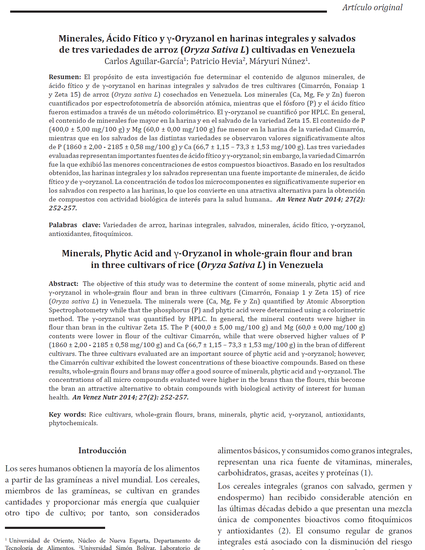
Article
Minerales, Ácido Fítico y γ-Oryzanol en harinas integrales y salvados de tres variedades de arroz (Oryza Sativa L) cultivadas en Venezuela
Anales Venezolanos de Nutricion
(2014)
Abstract
The objective of this study was to determine the content of some minerals, phytic acid and
γ-oryzanol in whole-grain flour and bran in three cultivars (Cimarrón, Fonaiap 1 y Zeta 15) of rice
(Oryza sativa L) in Venezuela. The minerals were (Ca, Mg, Fe y Zn) quantified by Atomic Absorption
Spectrophotometry while that the phosphorus (P) and phytic acid were determined using a colorimetric
method. The γ-oryzanol was quantified by HPLC. In general, the mineral contents were higher in
flour than bran in the cultivar Zeta 15. The P (400,0 ± 5,00 mg/100 g) and Mg (60,0 ± 0,00 mg/100 g)
contents were lower in flour of the cultivar Cimarrón, while that were observed higher values of P
(1860 ± 2,00 - 2185 ± 0,58 mg/100 g) and Ca (66,7 ± 1,15 – 73,3 ± 1,53 mg/100 g) in the bran of different
cultivars. The three cultivars evaluated are an important source of phytic acid and γ-oryzanol; however,
the Cimarrón cultivar exhibited the lowest concentrations of these bioactive compounds. Based on these
results, whole-grain flours and brans may offer a good source of minerals, phytic acid and γ-oryzanol. The
concentrations of all micro compounds evaluated were higher in the brans than the flours, this become
the bran an attractive alternative to obtain compounds with biological activity of interest for human
health.
Keywords
- Variedades de arroz,
- harinas integrales,
- salvados,
- minerales,
- ácido fítico,
- γ-oryzanol
Disciplines
Publication Date
2014
Citation Information
Carlos Aguilar-García, Patricio Hevia, Máryuri Núnez. 2014. Minerales, Ácido Fítico y γ-Oryzanol en harinas integrales y salvados de tres variedades de arroz (Oryza Sativa L) cultivadas en Venezuela. An. Venez. Nutr. 27(2):252-257.
